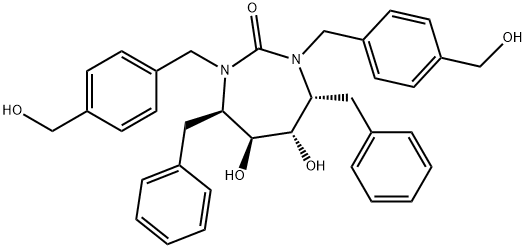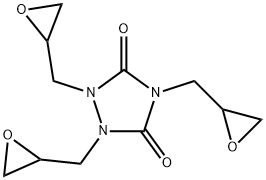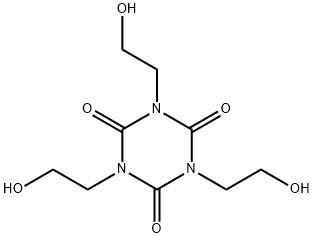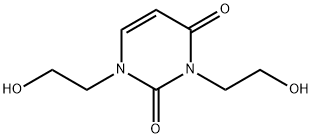N,N'-BIS(2-HYDROXYETHYL)-UREA
- CAS NO.:15438-70-7
- Empirical Formula: C5H12N2O3
- Molecular Weight: 148.16
- MDL number: MFCD00522193
- SAFETY DATA SHEET (SDS)
- Update Date: 2023-04-23 13:52:06

What is N,N'-BIS(2-HYDROXYETHYL)-UREA?
Preparation
Excess ethanolamine and DMDTC were mixed and heated at 60℃ for 15 h. The released malodorous methyl sulfide by-product was absorbed and oxidized by NaOCl solution. When the reaction was complete, the unreacted ethanolamine was removed under reduced pressure by simple distillation, leaving a crude mixture of oxazolidinone and bis(2-hydroxyethyl)urea, which was further purified by recrystallization from methanol/ethyl acetate (1:4.5) to give N,N'-bis(2-hydroxyethyl)urea as colorless crystals.
Properties of N,N'-BIS(2-HYDROXYETHYL)-UREA
| Melting point: | 83 °C |
| Boiling point: | 445.1±30.0 °C(Predicted) |
| Density | 1.226±0.06 g/cm3(Predicted) |
| storage temp. | -20°C Freezer, Under inert atmosphere |
| solubility | DMSO (Slightly) |
| form | Solid |
| pka | 13.09±0.46(Predicted) |
| color | Off-White to Light Beige |
| EPA Substance Registry System | Urea, N,N'-bis(2-hydroxyethyl)- (15438-70-7) |
Safety information for N,N'-BIS(2-HYDROXYETHYL)-UREA
| Signal word | Warning |
| Pictogram(s) |
 Exclamation Mark Irritant GHS07 |
| GHS Hazard Statements |
H302:Acute toxicity,oral H315:Skin corrosion/irritation H319:Serious eye damage/eye irritation H335:Specific target organ toxicity, single exposure;Respiratory tract irritation |
| Precautionary Statement Codes |
P261:Avoid breathing dust/fume/gas/mist/vapours/spray. P264:Wash hands thoroughly after handling. P264:Wash skin thouroughly after handling. P270:Do not eat, drink or smoke when using this product. P271:Use only outdoors or in a well-ventilated area. P280:Wear protective gloves/protective clothing/eye protection/face protection. P362:Take off contaminated clothing and wash before reuse. P302+P352:IF ON SKIN: wash with plenty of soap and water. P305+P351+P338:IF IN EYES: Rinse cautiously with water for several minutes. Remove contact lenses, if present and easy to do. Continuerinsing. P332+P313:IF SKIN irritation occurs: Get medical advice/attention. P337+P313:IF eye irritation persists: Get medical advice/attention. P405:Store locked up. P403+P233:Store in a well-ventilated place. Keep container tightly closed. P501:Dispose of contents/container to..… |
Computed Descriptors for N,N'-BIS(2-HYDROXYETHYL)-UREA
New Products
4-AMINO-TETRAHYDRO-PYRAN-4-CARBOXYLIC ACID HCL 4-(Dimethylamino)tetrahydro-2H-pyran-4-carbonitrile 4-Aminotetrahydropyran-4-carbonitrile Hydrochloride (R)-3-Aminobutanenitrile Hydrochloride 3-((Dimethylamino)methyl)-5-methylhexan-2-one oxalate 1,4-Dioxa-8-azaspiro[4.5]decane 5-Bromo-2-nitropyridine Nimesulide BP Aceclofenac IP/BP/EP Diclofenac Sodium IP/BP/EP/USP Mefenamic Acid IP/BP/EP/USP Ornidazole IP Diclofenac Potassium THOMAIND PAPER PH 2.0 TO 4.5 1 BOX BUFFER CAPSULE PH 9.2 - 10 CAP SODIUM CHLORIDE 0.1N CVS ALLOXAN MONOHYDRATE 98% PLATINUM 0.5% ON 3 MM ALUMINA PELLETS (TYPE 73) LITHIUM AAS SOLUTION 2-Bromo-1-(bromomethyl)-3-chloro-5-nitrobenzene 2-Bromo-3-nitroaniline N-(3-Hydroxypropyl)-N-methylacetamide 3-Bromo-6-chloropyridazine 4-ethyl-3-nitrobenzoic acidRelated products of tetrahydrofuran








You may like
-
 N,N'-Bis(2-hydroxyethyl)urea 97% CAS 15438-70-7View Details
N,N'-Bis(2-hydroxyethyl)urea 97% CAS 15438-70-7View Details
15438-70-7 -
 N,N'-Di-(2-hydroxyethyl)urea 98% (HPLC) CAS 15438-70-7View Details
N,N'-Di-(2-hydroxyethyl)urea 98% (HPLC) CAS 15438-70-7View Details
15438-70-7 -
 1823368-42-8 98%View Details
1823368-42-8 98%View Details
1823368-42-8 -
 2-(3-(tert-butyl)phenoxy)-2-methylpropanoic acid 1307449-08-6 98%View Details
2-(3-(tert-butyl)phenoxy)-2-methylpropanoic acid 1307449-08-6 98%View Details
1307449-08-6 -
 Ethyl 3-(furan-2-yl)-3-hydroxypropanoate 25408-95-1 98%View Details
Ethyl 3-(furan-2-yl)-3-hydroxypropanoate 25408-95-1 98%View Details
25408-95-1 -
 2-Chloro-5-fluoro-1-methoxy-3-methylbenzene 98%View Details
2-Chloro-5-fluoro-1-methoxy-3-methylbenzene 98%View Details
1805639-70-6 -
 1784294-80-9 98%View Details
1784294-80-9 98%View Details
1784294-80-9 -
 Lithium ClavulanateView Details
Lithium ClavulanateView Details
61177-44-4
Statement: All products displayed on this website are only used for non medical purposes such as industrial applications or scientific research, and cannot be used for clinical diagnosis or treatment of humans or animals. They are not medicinal or edible.